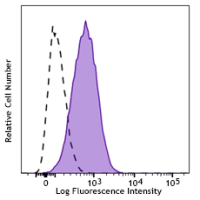-
Sign In
-

-
 Sony Biotechnology
Sony Biotechnology
-

-
 Sony Biotechnology
Sony Biotechnology
Brilliant Violet 711™ anti-human MERTK
Antibodies Single
Sony
590H11G1E3
Flow Cytometry
Mouse IgG1, κ
Human
MERTK extracellular domain/Fc fusion.
2438100
$480.00
Description
MERTK plays a role in the retinal pigment epithelium as a regulator of rod outer segments fragments phagocytosis. MERTK also plays a role in the inhibition of Toll-like receptor-mediated innate immune responses through the activation of STAT1. Upregulation of MERTK seems to also promote the survival of certain cancer cells, such as t(1;19)-positive acute lymphoblastic leukemias (ALL). MERTK also has a role in cellular migration, as MERTK KO macrophages demonstrate cytoskeletal disruptions that impacts its shape and directional migration. Melanoma cells express high levels of MERTK, which makes this molecule an attractive therapeutic target.
Formulation
Phosphate-buffered solution, pH 7.2, containing 0.09% sodium azide and BSA (origin USA).Recommended Usage
Each lot of this antibody is quality control tested by immunofluorescent staining with flow cytometric analysis. For flow cytometric staining, the suggested use of this reagent is 5 µl per million cells in 100 µl staining volume or 5 µl per 100 µl of whole blood.
Brilliant Violet 711™ excites at 405 nm and emits at 711 nm. The bandpass filter 710/50 nm is recommended for detection, although filter optimization may be required depending on other fluorophores used. Be sure to verify that your cytometer configuration and software setup are appropriate for detecting this channel. Refer to your instrument manual or manufacturer for support. Brilliant Violet 711™ is a trademark of Sirigen Group Ltd.
This product is subject to proprietary rights of Sirigen Inc. and is made and sold under license from Sirigen Inc. The purchase of this product conveys to the buyer a non-transferable right to use the purchased product for research purposes only. This product may not be resold or incorporated in any manner into another product for resale. Any use for therapeutics or diagnostics is strictly prohibited. This product is covered by U.S. Patent(s), pending patent applications and foreign equivalents.
References
- Rogers AE, et al. 2012. Oncogene 31:4171.


